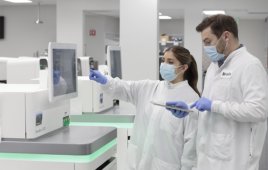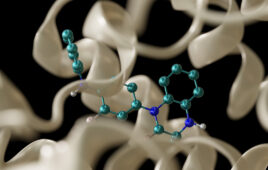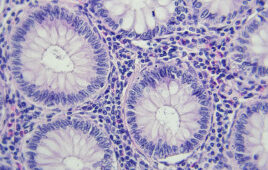Researchers still using 2D-PAGE prove that you can teach an old dog new tricks by improving this powerful technology.
 click to enlarge Illustrated here is a gradient gel cast using a2DEoptimizer. (Source: Novartis Pharmaceuticals) |
Two-dimensional polyacrylamide gel electrophoresis (2D-PAGE) is a reliable technique with a proven track record for identification and qualitative analysis of proteins. With the advent of newer proteomics technologies, one might expect 2D-PAGE to decline in popularity. Far from it; this older technology is more popular than ever and gaining ground, even against flashier techniques like mass spectrometry (MS).
Advances in 2D-PAGE technology and more powerful data acquisition and analysis tools have changed all the rules. Unlike the “old days” of PAGE, complex protein sample resolution and quantification can now be undertaken with a high degree of reproducibility.
21st century 2D-PAGE
There are several key technologies that have revolutionized 2D-PAGE. One is the commercial availability of pre-cast isoelectric focusing strips. These can be purchased in either a very narrow pH range (3.5 to 4.5, for example), or a broad range (such as 3 to 8). The narrow range, in particular, has a much higher resolving power, and because the gels are pre-cast and made by machine, they eliminate one of the greatest sources of variability of the manually-prepared 2D gel.
Invitrogen’s (Carlsbad, Cailf.) zoom IPG strip is a thin, 8-cm long gel that uses carrier molecules called ampholytes to stabilize the pH inside the gel. After an equilibration step, the finished zoom strip can be loaded into the NuPage or Novex 2D-PAGE systems for separation by molecular weight. Invitrogen’s small format gels have a number of advantages over traditional large-format gels.
“With large-format gels, there’s lots of space between proteins. It’s good if you don’t know what you are looking for, and don’t want your spots to be too close,” says Evangeline Gonzalez, vice president of protein analysis for Invitrogen. “Invitrogen’s products are a mini-size, or small format. People tend to use them for very quick runs, when they know what they are looking for and want to screen to see if their proteins are still active.”
Modern fluorescent dyes have also changed the landscape in 2D-PAGE. This is what has made it truly possible to obtain accurate quantitative information from a gel, because the fluorescence can be measured precisely and the total protein amount calculated. A variation on 2D-PAGE called difference gel electrophoresis (DIGE), uses three different “Cy” dyes to label up to three samples, which are then mixed and resolved in one gel. The technique is uniquely powerful for protein expression studies.
Ira Goldknopf, a pioneer of 2D-PAGE and chief scientific officer of Power3 Medical Products, The Woodlands, Texas, describes what it was like in the 1970s, when he first used the technique to isolate a newly discovered protein. “In the old days, we used to stain the gels with coomassie blue, then take a picture of it with a camera in a dark room. If it was dark, we gave it four pluses, faint, one plus. It was not really quantitative, and it was nonlinear.”
The new fluorescent dyes coupled with digital imaging technology provide detection and quantification light-years beyond the “dark ages” of the coomassie blue estimation method. “We find that we can use quantitative 2D-gel electrophoresis to quantify proteins quite well. We have looked across the entire linear range and we have found coefficients of variation of less than or equal to 20% when we have run samples on multiple 2D gels,” says Goldknopf.
|
Biomarker discovery
Because of its ability to resolve thousands of proteins at once, and compare expression levels between different states, 2D-PAGE has become an attractive proteomics method for biomarker discovery.
“We at Power3 have analyzed more than 650 samples from patients with various neurodegenerative diseases, including Alzheimer’s, Parkinson’s, Lou Gehrig’s disease and similar disorders,” says Goldknopf in describing applications for 2D-PAGE. “Also, with respect to breast cancer, we have analyzed more than 700 patient samples. In these cases, the samples have been retrospective and prospective, and we get reproducibility. It’s efficient enough for us that we can distinguish patients from normal and disease controls with a high degree of sensitivity and specificity.”
NextGen Sciences, Ann Arbor, Mich., also offers 2D-PAGE analysis to its clients in the area of discovery research. Additionally, they provide precast gels, or, better, the machine used to make the gels. Although buying the gel itself is a great convenience, for a large number of gels, the a2DEoptimizer instrument is an economical investment. Using gradient gels created on the a2DEoptimizer, NextGen reports a coefficient of variation of only 3.5% between gels, demonstrating a very high level of reproducibility.
Gradient gels offer the better molecular weight resolution than non-gradient gels. “It gives you increased resolution,” says Mike Pisano, president and CEO of NextGen Sciences. “You start to see spots that appear to be one spot and separate into multiple spots.” In fact, resolution on a 2D gradient gel is often so tight that different isoforms of a single protein can be resolved, or differences in phosphorylation state.
Like using the pre-cast, narrow-band isoelectric focusing gels, using a pre-cast or machine-made gradient gel for the second dimension eliminates a major source of inter-gel variability. 2D-PAGE also offers advantages over higher profile techniques such as mass spectrometry or column electrophoresis. The mass spectrometer is not designed for optimal protein fractionation, and can’t handle the thousands of proteins that might be found in a single sample. And column chromatography, while it provides good fractionation, can’t achieve the resolution of 2D-PAGE. These other techniques are, however, complementary, and in combination can achieve even better results at characterizing proteins. In fact, alternate forms of 2D-PAGE are beginning to appear, using either different separations for the first two dimensions (such as native gel in the first dimension, and denaturing in the second), or adding liquid chromatography or MS separations as additional “dimensions” of separation, so that you could imagine a third, fourth, or fifth dimensional protein separation.
About the Author
Catherine Shaffer is a freelance science writer specializing in biotechnology and related disciplines with a background in laboratory research in the pharmaceutical industry.
This article was published in Drug Discovery & Development magazine: Vol. 10, No. 12, December, 2007, pp. 44-45.
Filed Under: Genomics/Proteomics




